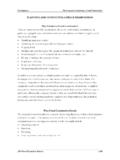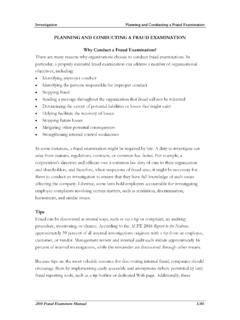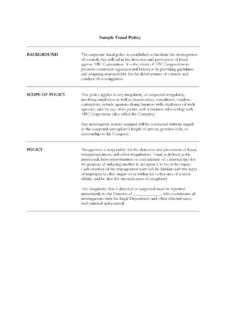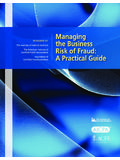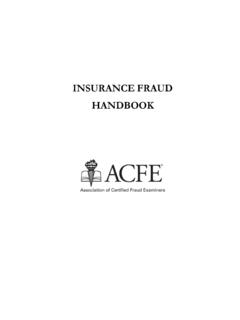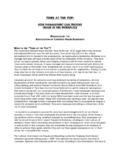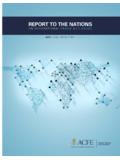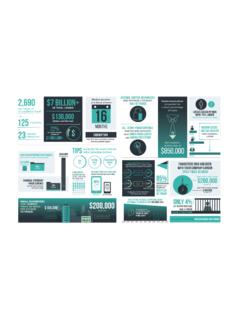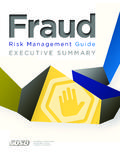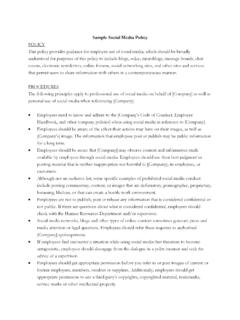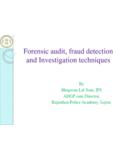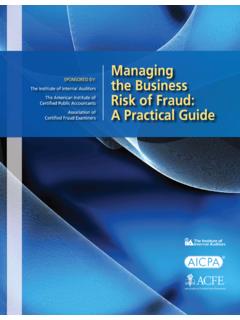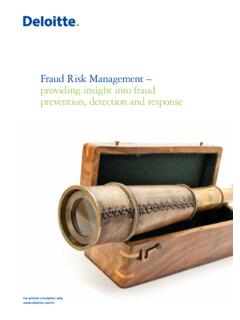Transcription of Managing Business Risk - Association of Certified Fraud ...
1 1 Managing the Business Risk of Fraud : A Practical GuideSponSored by:The Institute of Internal AuditorsThe American Institute of Certified public AccountantsAssociation of Certified Fraud examiners1 The views expressed in this document are for guidance purposes only and are not binding on organizations. Organizations should design and implement policies and procedures that best suit them. The IIA, AICPA, and ACFE shall not be responsible for organizations failing to establish policies and procedures that best suit their needs. This guide is intended to be applicable globally but heavily references practices in the United States and, where available, provides references to information from other countries, as well.
2 We anticipate further references will be included in future the SponSoring organizationS:the institute of internal auditorsDavid a. richards, Cia, CpaPresident and Project Managerthe american institute of Certified public accountantsBarry C. melancon, Cpa President and CEO Association of Certified Fraud examinersJames D. ratley, CFePresident2toby Bishop, Cpa, CFe, FCaDirector, Deloitte Forensic CenterDeloitte Financial Advisory Services LLPC orey Anne Bloom, CA, CA IFA, CFES enior Associate, Dispute Resolution and Financial Investigation Services RSM Richter Inc. Joseph V. Carcello, , Cia, Cpa, CmaDirector of Research, Corporate Governance CenterErnst & Young ProfessorUniversity of TennesseeDavid L.
3 Cotton, Cpa, CFe, CgFmChairmanCotton & Company LLPholly Daniels, Cia, CiSaTechnical Director, Standards and GuidanceThe Institute of Internal Auditorsronald L. Durkin, Cpa, CFe, CiraNational Partner in Charge, Fraud & Misconduct InvestigationsKPMG LLPD avid J. Elzinga, CA IFA, CFEP artner, Forensic Accounting & Investigation ServicesGrant Thornton LLProbert e. Farrell, CFePrincipal, White Collar InvestigationsBruce J. gavioli, Cpa, mBaPartner & National Leader, Anti- Fraud ConsultingDeloitte Financial Advisory Services LLPJohn D. gill, JD, CFeResearch DirectorAssociation of Certified Fraud ExaminersSandra K.
4 Johnigan, Cpa, CFeJohnigan, thomas m. miller, Cpa\aBV, CFe, piTechnical Manager, Forensic and Valuation ServicesAICPALynn morley, Cia, CgaMorley Consulting & Training Services Sanglier Partner Ernst & Young LLP Jeffrey SteinhoffManaging Director, Financial Management and Assurance (Retired) Government Accountability Office William e. Stewart Partner, Fraud Investigation & Dispute ServicesErnst & Young LLP Bill Warren Director, Fraud Risks and ControlsPricewaterhouseCoopers LLP mark F. zimbelman, Professor and Selvoy J. Boyer FellowBrigham Young University team memBerS:proJeCt aDViSorS:eleanor BloxhamChief Executive OfficerThe Value Alliance and Corporate Governance AllianceLarry harringtonVice President, Internal AuditRaytheon Company 3enDorSerS:The following organizations endorse the nonbinding guidance of this guide as being of use to management and organizations interested in making Fraud risk management programs work.
5 The views and conclusions expressed in this guide are those of the authors and have not been adopted, approved, disapproved, or otherwise acted upon by a committee, governing body, or the membership of the endorser. 4 Managing the Business Risk of Fraud : a PRactical guidetaBLe oF ContentS page INTRODUCTION 5 SECTION 1: Fraud RISK GOVERNANCE 10 SECTION 2: Fraud RISK ASSESSMENT 19 SECTION 3: Fraud PREVENTION 30 SECTION 4: Fraud detection 34 SECTION 5: Fraud INVESTIGATION AND CORRECTIVE ACTION 39 CONCLUDING COMMENTS 44appenDiCeS:APPENDIX A: REFERENCE MATERIAL 45 APPENDIX B: SAMPLE FRAMEWORK FOR A Fraud CONTROL POLICY 48 APPENDIX C: SAMPLE Fraud POLICY 50 APPENDIX D: Fraud RISK ASSESSMENT FRAMEWORK EXAMPLE 55 APPENDIX E.
6 Fraud RISK EXPOSURES 57 APPENDIX F: Fraud PREVENTION SCORECARD 61 APPENDIX G: Fraud detection SCORECARD 65 APPENDIX H: OCEG FOUNDATION PRINCIPLES THAT RELATE TO Fraud 69 APPENDIX I: COSO INTERNAL CONTROL INTEGRATED FRAMEWORK 79 ..5 Managing the Business Risk of Fraud : a PRactical guideFraud is any intentional act or omission designed to deceive others, resulting in the victim suffering a loss and/or the perpetrator achieving a All organizations are subject to Fraud risks. Large frauds have led to the downfall of entire organizations, massive investment losses, significant legal costs, incarceration of key individuals, and erosion of confidence in capital markets.
7 Publicized fraudulent behavior by key executives has negatively impacted the reputations, brands, and images of many organizations around the globe. Regulations such as the Foreign Corrupt Practices Act of 1977 (FCPA), the 1997 Organisation for Economic Co-operation and Development Anti-Bribery Convention, the Sarbanes-Oxley Act of 2002, the Federal Sentencing Guidelines of 2005, and similar legislation throughout the world have increased management s responsibility for Fraud risk to recent corporate scandals have led the public and stakeholders to expect organizations to take a no Fraud tolerance attitude.
8 Good governance principles demand that an organization s board of directors, or equivalent oversight body, ensure overall high ethical behavior in the organization, regardless of its status as public, private, government, or not-for-profit; its relative size; or its industry. The board s role is critically important because historically most major frauds are perpetrated by senior management in collusion with other employees2. Vigilant handling of Fraud cases within an organization sends clear signals to the public, stakeholders, and regulators about the board and management s attitude toward Fraud risks and about the organization s Fraud risk addition to the board, personnel at all levels of the organization including every level of management, staff, and internal auditors, as well as the organization s external auditors have responsibility for dealing with Fraud risk.
9 Particularly, they are expected to explain how the organization is responding to heightened regulations, as well as public and stakeholder scrutiny; what form of Fraud risk management program the organization has in place; how it identifies Fraud risks; what it is doing to better prevent Fraud , or at least detect it sooner; and what process is in place to investigate Fraud and take corrective action3. This guide is designed to help address these tough guide recommends ways in which boards4, senior management, and internal auditors can fight Fraud in their organization. Specifically, it provides credible guidance from leading professional organizations that defines principles and theories for Fraud risk management and describes how organizations of various sizes and types can 1 This definition of Fraud was developed uniquely for this guide, and the authors recognize that many other definitions of Fraud exist, including those developed by the sponsoring organizations and endorsers of this guide.
10 2 Refer to The Committee of Sponsoring Organizations of the Treadway Commission s (COSO s) 1999 analysis of cases of fraudulent financial statements investigated by the Securities and Exchange Commission (SEC).3 Refer to June 2007 SEC Commission Guidance Regarding Management s Report on Internal Control Over Financial Reporting Under Section 13(a) or 15(d) of the Securities Exchange Act of 1934 and Public Company Accounting Oversight Board (PCAOB) Auditing Standard No. 5 (AS5), An Audit of Internal Control Over Financial Reporting That Is Integrated With an Audit of Financial Statements, for comments on Fraud Throughout this paper the terms board and board of directors refer to the governing body of the organization.
